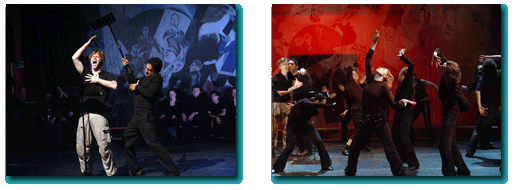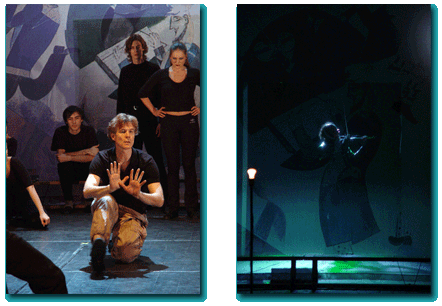
Green Violin in St. Petersburg
American creative team and actors traveled to St. Petersburg to work on an original American musical drama, Green Violin by Elise Thoron/Frank London, about Marc Chagall and the first Soviet Yiddish Theater’s leading actor, Solomon Mikhoels. The American team worked with a Russian actor, choreographer, violinist, local klezmer band (five musicians), and twenty music theater students from the St. Petersburg Theater Academy in rehearsals, culminating in two filled to capacity public presentations at the Theater on Mokhovaya (500+ seats), and other related public events. Audiences were enthusiastic about Green Violin, music, movement, and the bilingual format of the exchange; the piece itself evolved for future productions in Russia and the United States.
ARTISTIC RESULTS:
American composer, Frank London, developed the role of the “Green Violinist” with virtuoso gypsy violinist, Vladimir Oustinovsky, ( composer and leader of “Tsigansky Dvor” ensemble). Volodya’s playing, an exquisite combination of classical virtuosity and folk improvisation, inspired Frank to write several new violin solos. The violin was at the center of the presentations, carrying the soul of the piece. Volodya enjoyed working on Green Violin, observing firsthand how Frank wove traditional ethnic instrumentation into a score with diverse musical influences, experience Volodya can use to further develop his own “gypsy opera,” Tsigany (Gypsies).
With wonderful American music director, Mary-Mitchell Campbell, Frank wrote choral parts for the twenty students, who became our GOSET company (the first Soviet Yiddish Theater) in full voice. We had two young St. Petersburg pianists at all rehearsals as accompanists/observers, plus a local klezmer band “Dobra Noch’” (accordion, cymbalon, tuba, percussion, violins), who with Frank played additional public concerts.
Yuri Vasilkov, an extraordinary Russian choreographer, worked with American director, Rebecca Taichman, to develop movement for Green Violin. Yuri’s knowledge of the history of Russian dance and movement schools in Europe at the beginning of the 20th Century is extensive. He found evocative ways of conveying the complex evolution of the theater company’s style as it is increasingly influenced by Chagall’s paintings. Yuri showed the American creators how to make a compelling story of the company’s development with movement and stage pictures, rather than textual explanation. He had this story in his body and watching him move was illuminating.
Yuri’s rehearsals are a combination of movement (he is an amazing dancer), story telling, and rigorous pedagogy. His basic message to the students is that movement has to be grounded in the inner-life of their characters. He then gave a most moving talk about taking on the inner life of a Jew in Russia. Yuri also worked extensively and with great effect with Americans, Tom Nelis (a founding member of Ann Bogart’s SITI Company), and Manu Narayan, (Broadway lead of Bombay Dreams) who played Mikhoels and Zuskin, leading the company of students.
Audiences and students alike marveled at the Americans ability to act, sing and dance as one synthetic whole, which is not true of the Russians. The Russian students learned each day from the American’s example, teaching, and interactions outside of rehearsals.
The American company was stellar in its talent and devotion to the project, as artists, educators, and cultural ambassadors. They in turn had the time of their lives, and were introduced to many aspects of Russian culture and life of St. Petersburg, under the auspices of Alliance directors, Tanya & Niki Yermolaev, and the O”neill Theater Centers founder, George White, so it would be very difficult not to fall in love. For many seeing Lev Dodin’s Maly Dramatic Theater’s Uncle Vanya alone was worth the trip. Russia is still an incredibly nourishing and rich place for American theater artists, and the beauty of this exchange is that as music-theater practitioners they are able to give something quite unique to this place of phenomenal tradition and talent.
Many of the students considered this exchange the highpoint of their four years’ education at the Academy. The amount they learned from Rebecca, Mary-Mitchell and the ensemble of American actors working on this intensely of a challenging piece was incredible. The Russian students were also thrilled to have a chance to work with Yuri, (who usually trains drama students of Lev Dodin and works for the Maly Dramatic Theater). Music-theater is a bit of a second-class citizen at the Academy next to drama, so putting it at the forefront of attention with serious dramatic goals is vital for the students.

AUDIENCE RESPONSE
It was very moving to tell this Russian story in Russia, and audiences were deeply moved by it. Delving into Soviet past is not very popular now, nor Jewish themes, but the musical and theatrical nature of the piece won audiences and allowed entrance into the subject matter. Audiences ranged in age from people who had direct experience of the times presented on stage, to students who were children during Soviet era. While their teachers assured us they had covered the Soviet Yiddish Theater and Mikhoels in theater history courses, we found students actually knew little about it. The students’ growing engagement with the material was infectious and passed on to all their peers who came to rehearsals and performances.
The first night of our presentations was filled with illustrious Russian theater/arts cognoscenti, representatives from the American consulate and our supporters from the States, plus Academy professors, journalists etc. the performance (our first run through) was exciting. The second night the company hit their stride and the audience was more regular theatergoers for the Theater on Mokhovaya, (people who love seeing theater and can’t afford huge ticket prices). At end of the play there was that silence of recognition, then the dense unison applause that go on and on Russian style.
The public presentations focused much more on the music and movement than we originally anticipated, so our primary concern with the dramatic text was to convey the essential story to a Russian audience, if not every word. With a Russian actor playing one of the leading roles, Chagall, many of the scenes were bilingual, which some audience members really enjoyed. We cut down English text and added Russian narration/translation where necessary to be sure everyone got the basics.
CROSS-CULTURAL DIALOGUE
Throughout our process, quite naturally we all touched in one way or another by what it meant to be telling a story about a Soviet Jewish theater company, many of whose members lost their lives under Stalin, in today’s Russia. What does it mean to be Jewish now? How is it defined in post-Soviet culture, where it’s still a nationality on a passport, but no longer a liability, or is it? These questions swirled around us with the fun of seeing Frank and Dobra Noch’ all decked out in shades playing “klezmer” in a popular “rock” club to a dancing crowd, or being given a home cooked banquet in the local synagogue. But also in the strangeness of being told by a Jewish family, who had lived in the same home for generations in St. Petersburg, surviving the Blockade, that they were happy their children were now all living in Germany, because it was “safer.”
What I was left with was how inextricably bound Russian and Jewish cultures are in everything from food, music, soul and expression. They are hard to separate and yet vitriolic outbursts of Anti-Semitism and underlying prejudice are still about common as they are in other parts of the world, but with a lethal recent history behind them. Tendrils of Jewish secular culture are growing in many places and the process of renewal is a joyous, but uneasy one. Green Violin exhumes and explores, mostly in a celebratory mode, the history of the Soviet Yiddish Theater, but nevertheless that is a thorny process.
When interviewing Russian professional actors for the piece, all asked me: “So how will I play a “Jew?” or “You know I’m not Jewish?” or “I don’t look Jewish, is that okay?” It seemed in the representation of Jews on stage there are certain iconic characteristics that people are looking for, whereas in contemporary life it is often hard to tell someone’s background. In casting on the American side, we went against the stereotype and chose one actor with fierce talent and non-Jewish appearance, who would be fabulous in the role of Zuskin. Thus, a young American from Pittsburgh with Indian background nearly stole the show and all the students’ hearts. And as a “dark” person in St. Petersburg, clearly a minority, playing a Jew, Manu toppled many obvious stereotypes, with his beautiful work and spirit. I had an interesting exchange with dear friend and well-known theater director in St. Petersburg, whose main criticism of the presentation was that “it wasn’t Jewish enough” – yet the actor he would not stop raving about, who evoked this elusive spirit for him was Manu. So the layers of cross-cultural exchange were many and the dialogue rich. |
